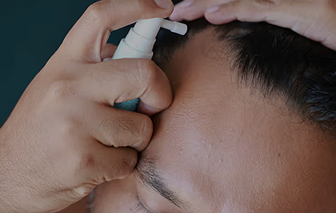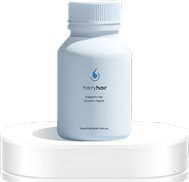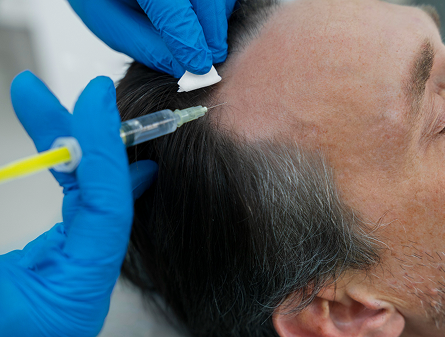Finasteride is a dihydrotestosterone (DHT) blocker. DHT is one of the main causes of pattern hair loss as it binds to hair follicles to gradually shrink them, shortening the hair growth cycle and eventually causing hair to fall out. Dutasteride is also a DHT blocker but is more potent than finasteride.
It works by blocking all three types of isoenzymes that are responsible for converting testosterone into DHT whereas finasteride only blocks two. Finasteride has been shown in studies to lower DHT levels in the scalp by up to 72 per cent.
Dutasteride has not been approved as a hair loss treatment outside of Japan and South Korea but can be prescribed off-label to tackle hair thinning. Explore the comparison table below to see how finasteride and dutasteride stack up.
- Finasteride is a prescription medication that blocks two types of 5-alpha reductase to lower DHT and slow hair loss.
- Unlike dutasteride, it’s more commonly used and approved for hair loss in many regions.
- Dutasteride inhibits all three types of 5-alpha reductase enzymes for broader DHT suppression.
- Compared to finasteride, it’s more potent but less commonly prescribed for hair loss and is used off-label.
- Finasteride typically costs $30–$70 per month.
- Generally, more affordable and widely available than dutasteride.
- Dutasteride ranges from $40 to $80 per month in Australia.
- It may cost more than finasteride and be harder to find.
- Finasteride is taken daily, with results usually visible within 3–6 months.
- Long-term commitment is required to maintain hair retention.
- Dutasteride is taken once daily and delivers visible results in a similar timeframe.
- Its longer half-life may sustain regrowth for longer in some users than finasteride.
- Finasteride is taken orally and works internally to reduce DHT production.
- It explicitly targets two types of enzymes responsible for scalp DHT.
- Dutasteride is oral and inhibits all three types of enzymes, including the two most common causes of pattern baldness.
- Unlike finasteride, it offers a more comprehensive approach to lowering DHT.
- Finasteride may cause side effects like reduced libido or mood changes.
- Considered safe under supervision but carries hormonal risks.
- Dutasteride shares similar side effects but may be more intense due to stronger DHT suppression.
- Compared to Finasteride, it requires closer monitoring for side effects.
- Finasteride is taken as one tablet daily with minimal disruption.
- Easy to fit into daily routines.
- Dutasteride is also a once-daily pill.
- Unlike finasteride, it may require additional consultation for off-label use.
- Finasteride is widely prescribed in Australia for male pattern baldness.
- More commonly accepted and available through GPs.
- Dutasteride is available via prescription but is less commonly offered for hair loss.
- Compared to finasteride, it may require off-label consent or specialist approval.
- Finasteride maintains results while taken, but loss resumes if stopped.
- Effects are sustainable with continued use.
- Dutasteride offers longer-lasting suppression of DHT and may provide more effective long-term results.
- Unlike finasteride, benefits may persist slightly longer after discontinuing.
- Finasteride is often used with minoxidil or laser therapy to enhance results.
- Complements external treatments well.
- Dutasteride also pairs with topicals like minoxidil and microneedling.
- Compared to finasteride, it is more powerful and sometimes preferred when finasteride fails.
- Finasteride appeals to users seeking a proven, trusted treatment for male hair loss.
- Seen as a reliable first option in the treatment of hair loss.
- Dutasteride appeals to those needing more decisive intervention or who didn’t respond to finasteride.
- Unlike finasteride, it’s perceived as a more advanced or aggressive choice.
- Finasteride may also support prostate health by reducing DHT.
- It works systemically to encourage hair retention.
- Dutasteride is more effective for prostate conditions due to broader DHT reduction.
- Compared to Finasteride, it offers a broader health impact but more substantial hormonal effects.
- Finasteride generates ongoing pharmaceutical packaging waste.
- Creates a consistent environmental footprint over time.
- Dutasteride also contributes to regular prescription waste.
- Environmentally similar to Finasteride in terms of packaging impact.
Shop our hair solutions
We are committed to providing affordable hair regeneration services for people all over Australia. Our formula can help you regain your confidence.
Shop Now

Finasteride vs Dutasteride For Hair Regrowth Comparison Summary
When it comes to dutasteride vs finasteride price, it can depend on your location and how you access the medication. Finasteride usually requires a prescription with the approval of a doctor. These can now be accessed from home and are often combined with other hair growth ingredients.
Dutasteride prices can vary and are typically more expensive than finasteride but costs can fluctuate based on where you acquire it. Finasteride results can be observed as soon as 3 months after consistent treatment but significant results should be seen after 6 months. It is designed as a long-term treatment so if it is stopped the results can reverse.
Dutasteride has a similar time frame for results but it can irreversibly bind to the isoenzymes and has a longer half-life meaning that Dutasteride hair growth can be maintained for longer if the medication is discontinued or spaced out more than finasteride. Dutasteride in Australia is usually recommended if you have already tried finasteride and have not seen results.
Dutasteride vs Finasteride For Hair Loss User Guidance
While you may be looking at topical finasteride vs dutasteride, the medications are typically taken as oral solutions. Oral finasteride is usually well tolerated but there are some potential side effects. These centre around sexual dysfunction including the loss of libido, erectile dysfunction, and ejaculation problems.
Dutasteride also has a similar risk of systemic side effects. Finasteride side effects were observed in less than 2 per cent of patients in one study while dutasteride side effects were observed in less than 1 per cent of patients. Finasteride is pretty widely available and can be accessed through online subscription services.
Dutasteride may be more difficult to acquire as it may require consulting with a GP and it may only be prescribed if you have already tried finasteride and have not observed any hair growth improvements.
Take Our Hair Loss Quiz to See Which Treatment Suits You?
Take A Hair Quiz

Frequently Asked Questions
We have put some commonly asked questions.
Nunc scelerisque tincidunt elit. Vestibulum non mi ipsum. Cras pretium suscipit tellus sit amet aliquet. Vestibulum maximus lacinia massa nontor.
Platelet-rich plasma (PRP) treatment involves drawing blood from the patient, isolating the beneficial nutrients and injecting it into the scalp where hair loss is occurring. This promotes hair growth and has many other applications from encouraging healing to skin rejuvenation.
Platelet-rich plasma (PRP) treatment involves drawing blood from the patient, isolating the beneficial nutrients and injecting it into the scalp where hair loss is occurring. This promotes hair growth and has many other applications from encouraging healing to skin rejuvenation.
Platelet-rich plasma (PRP) treatment involves drawing blood from the patient, isolating the beneficial nutrients and injecting it into the scalp where hair loss is occurring. This promotes hair growth and has many other applications from encouraging healing to skin rejuvenation.







 See All
See All